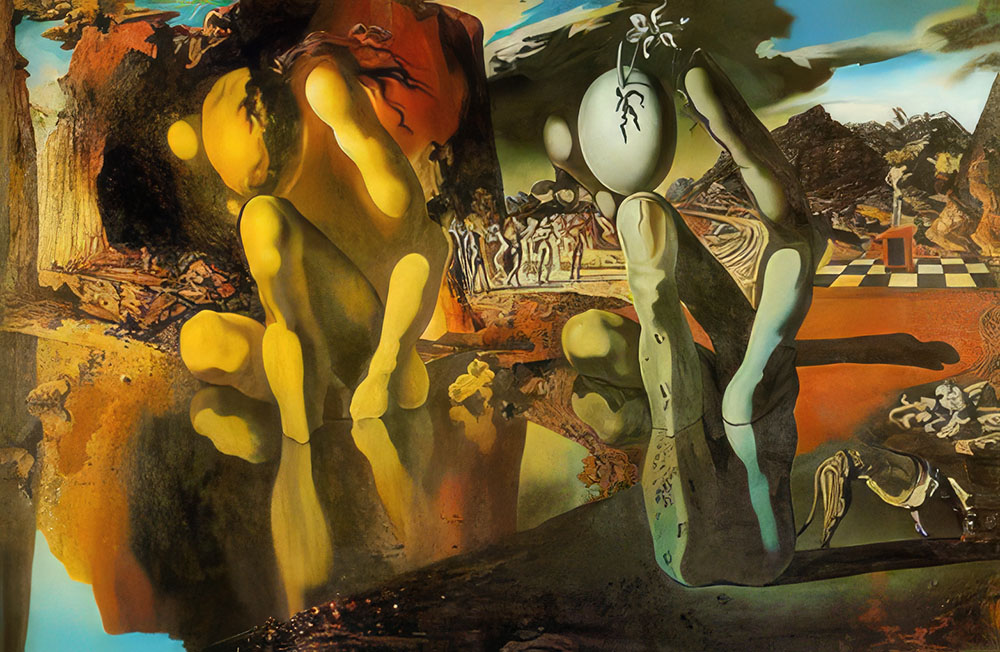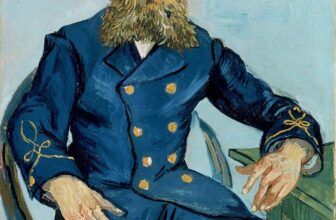
Meaning of The Metamorphosis of Narcissus Painting
In the surrealist realm of Salvador Dalí, few works embody the fusion of myth, psychology, and visual illusion as powerfully as The Metamorphosis of Narcissus. Completed in 1937, this painting stands not only as a technical triumph but as a profound psychological and symbolic commentary, rooted in classical mythology, yet fully modern in execution and interpretation.
This isn’t merely a painting; it is a philosophical mirror, a riddle wrapped in the uncanny language of dreams. What unfolds on Dalí’s canvas is a metamorphosis, not only of a mythological figure but of perception itself. So, what exactly is The Metamorphosis of Narcissus all about? And what lies beneath the enigmatic imagery?
Salvador Dalí and His Surreal Universe
To understand the painting, one must first understand the painter. Salvador Dalí, born in 1904 in Figueres, Spain, was a master of the Surrealist movement, an avant-garde art movement that sought to channel the unconscious mind, dreams, and irrationality into artistic expression.
By the time he painted The Metamorphosis of Narcissus, Dalí was already a force within Surrealism. Inspired by Sigmund Freud’s theories on psychoanalysis and dreams, Dalí developed what he called the “paranoiac-critical method”, a creative technique aimed at tapping into the subconscious through deliberate self-induced hallucinations and optical illusions. This method is central to understanding how The Metamorphosis of Narcissus was conceived and painted.
How and When Was The Metamorphosis of Narcissus Painted?
Dalí painted The Metamorphosis of Narcissus in 1937 during a stay in England with the poet Edward James, a key patron of Surrealist art. It was during this time that Dalí also wrote an accompanying poem of the same title, which helps illuminate the painting’s deeper symbolic meaning.
Dalí painted the work using oil on canvas, a traditional medium, but infused it with his revolutionary approach to perspective, symbolism, and illusion. The painting is a product of intense psychological introspection and mythological inspiration, guided by his fascination with Freudian theory and ancient stories.
What Is The Metamorphosis of Narcissus All About?
At its core, The Metamorphosis of Narcissus is a reinterpretation of the Greek myth of Narcissus, a beautiful youth who falls in love with his own reflection in a pool of water. Unable to tear himself away from the image, Narcissus wastes away and is ultimately transformed into a flower.
However, Dalí’s version of the myth goes far beyond a simple retelling. It is a psychoanalytic allegory, exploring the nature of self-obsession, identity, death, and rebirth. Dalí translates this narrative into visual metaphor through a process of double imagery, a hallmark of his paranoiac-critical method.
What Is Happening in The Metamorphosis of Narcissus Painting?
The canvas is divided into two mirrored halves, creating a powerful symmetry that reflects the theme of narcissistic reflection. On the left side, Dalí depicts a crumbling, kneeling figure, Narcissus himself, gazing down into a pool of water. His body is contorted and almost statuesque, signifying decay and paralysis. This figure is detailed with painstaking realism, set against a desolate, mountainous backdrop.
On the right side, a hand, almost identical in shape to the bent figure, emerges from the earth, holding a cracked egg. From this egg, a delicate narcissus flower blooms. The hand is fossil-like, suggestive of death, yet the flower it holds symbolizes rebirth and transformation.
This juxtaposition is the crux of the painting: one image (Narcissus) decomposes into another (the flower), and vice versa. The myth is not just shown but transformed. The pool of water becomes a medium of metamorphosis, where the psychological and physical mirror each other.
In the background, small figures and a chessboard appear, clues that further enrich the symbolic fabric. These minor elements are not distractions; they echo themes of logic vs. emotion, strategy vs. instinct, structure vs. chaos.
Symbolism and Meaning: Cracking the Surrealist Code
Dalí’s work is never literal. Instead, he uses symbolic shorthand to explore inner realities. In The Metamorphosis of Narcissus, each element is freighted with meaning:
1. Narcissus Figure:
The central figure on the left is emaciated and rigid, symbolizing the death of the self through obsessive introspection. Dalí renders him as a marble statue, indicating emotional and spiritual paralysis.
2. The Hand with the Egg:
The hand on the right is a visual echo of Narcissus. Where Narcissus is decaying, the hand is delivering renewal, the cracked egg and flower symbolizing new life emerging from death. The egg is a potent Surrealist symbol, often linked to birth, potential, and fragility.
3. The Narcissus Flower:
This flower is not just a mythological device; it is a psychological resolution. Where the human Narcissus is doomed by his vanity, the flower becomes a purified, natural version, free from ego.
4. Water:
The reflective pool where Narcissus gazes symbolizes the subconscious. Water often represents emotion, mystery, and the unknowable. In this context, it is the mirror of identity, both the site of fascination and destruction.
5. Background Figures:
A group of onlookers can be seen in the middle distance, perhaps representing society or the conscious self, watching the internal drama from afar. The chessboard further back is often interpreted as a reference to calculated moves, possibly representing the mind’s attempt to rationalize emotion.
What Type of Art Is The Metamorphosis of Narcissus?
The Metamorphosis of Narcissus is quintessentially Surrealist art, characterized by dreamlike imagery, irrational juxtapositions, and visual illusion. But it is also heavily psychoanalytic, fusing classical myth with modern psychological insight.
This painting is also an example of Dalí’s “double image” technique, in which one object is simultaneously rendered as two. This technique blurs the line between reality and illusion, forcing the viewer to confront the ambiguity of perception.
In essence, it is not just art, but an exercise in perceptual and philosophical deconstruction.
Literary Companion: Dalí’s Poem “The Metamorphosis of Narcissus”
To accompany the painting, Dalí wrote a poem of the same name. It begins:
“Narcissus,
in his immobility,
absorbed by his reflection…”
The poem is an extension of the painting’s narrative, offering an emotional and symbolic commentary. It deepens the viewer’s engagement with the myth and Dalí’s transformation of it. In both painting and poem, the central message is clear: Self-obsession leads to disintegration, but from disintegration arises transformation.
Dalí’s exploration is more than aesthetic, it is existential. Narcissus is not merely a mythological character; he is a mirror for every individual grappling with identity, ego, and rebirth.
Where Is The Metamorphosis of Narcissus Painting Today?
The Metamorphosis of Narcissus is currently housed at the Tate Modern in London, United Kingdom. It remains one of the most celebrated pieces in their Surrealism collection and continues to captivate viewers from around the world.
The Tate acquired the painting as a gift from Edward James, Dalí’s friend and patron, who also appears in other Dalí works such as Swans Reflecting Elephants. James recognized the importance of Surrealism as a cultural movement and played a crucial role in preserving its masterpieces.
Visitors to the Tate can view the painting up close and appreciate not just its surreal content, but its technical brilliance, the clarity, precision, and richness of Dalí’s brushwork, which rivals the Old Masters.
The Enduring Power of Metamorphosis
Dalí’s The Metamorphosis of Narcissus is more than a painting, it is a mirror to the human psyche. By weaving together myth, psychology, and illusion, Dalí invites us into a meditation on the nature of the self. Are we static like statues, or fluid like water? Are we bound by ego, or capable of transformation?
In this single frame, Dalí accomplishes what few artists ever do: he fuses classical wisdom with modern anxiety, personal insight with universal truth. The viewer is left to ponder not only what the painting means but what they see in it, because like Narcissus, we all stare into the pool and seek our reflection.
And perhaps, if we look long enough, we too will undergo a metamorphosis.




